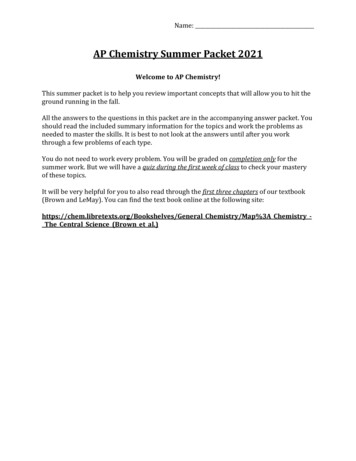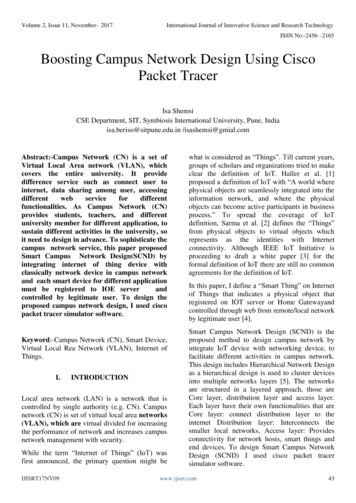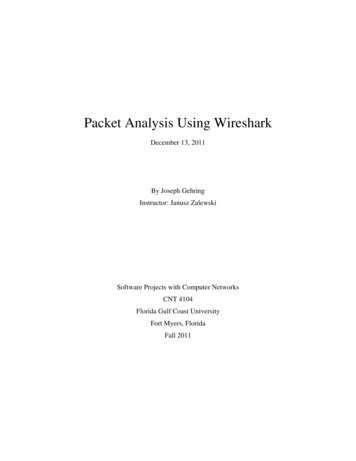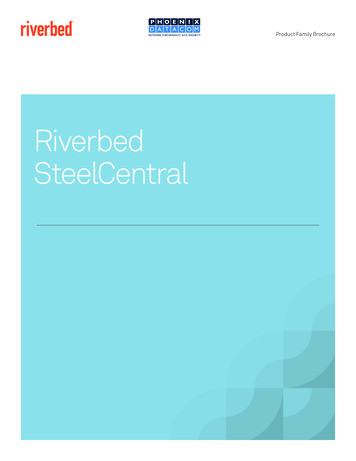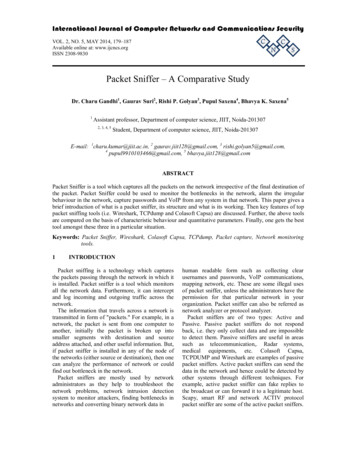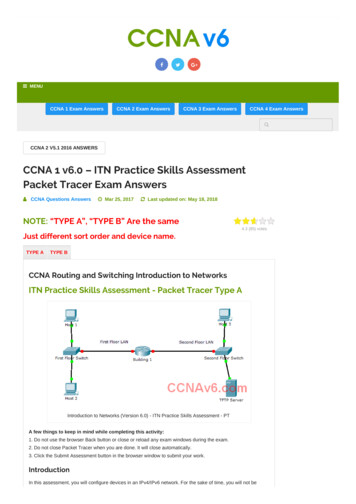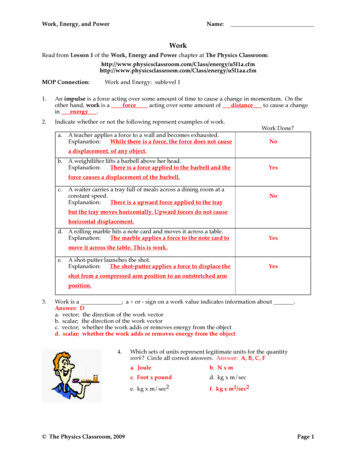
Transcription
Work, Energy, and PowerName:WorkRead from Lesson 1 of the Work, Energy and Power chapter at The Physics s/energy/u5l1aa.cfmMOP Connection:Work and Energy: sublevel 11.An impulse is a force acting over some amount of time to cause a change in momentum. On theother hand, work is a force acting over some amount of distance to cause a changein energy .2.Indicate whether or not the following represent examples of work.Work Done?a.A teacher applies a force to a wall and becomes exhausted.Explanation:While there is a force, the force does not causeNoa displacement. of any object.b.A weightlifter lifts a barbell above her head.Explanation:There is a force applied to the barbell and theYesforce causes a displacement of the barbell.c.A waiter carries a tray full of meals across a dining room at aconstant speed.Explanation:There is a upward force applied to the trayNobut the tray moves horizontally. Upward forces do not causehorizontal displacement.d. A rolling marble hits a note card and moves it across a table.Explanation:The marble applies a force to the note card toYesmove it across the table. This is work.e.A shot-putter launches the shot.Explanation:The shot-putter applies a force to displace theYesshot from a compressed arm position to an outstretched armposition.3.Work is a ; a or - sign on a work value indicates information about .Answer: Da. vector; the direction of the work vectorb. scalar; the direction of the work vectorc. vector; whether the work adds or removes energy from the objectd. scalar; whether the work adds or removes energy from the object4. The Physics Classroom, 2009Which sets of units represent legitimate units for the quantitywork? Circle all correct answers. Answer: A, B, C, Fa. Jouleb. N x mc. Foot x poundd. kg x m/sece. kg x m/sec2f. kg x m2/sec2Page 1
Work, Energy, and PowerThe amount of work (W) done on an object by a given force can be calculated usingthe formulaW F d cos Θwhere F is the force and d is the distance over which the force acts and Θ is theangle between F and d. It is important to recognize that the angle included in theequation is not just any old angle; it has a distinct definition that must beremembered when solving such work problems.5.For each situation below, calculate the amount of work done by the applied force. PSYWA 100 N force is applied tomove a 15 kg object ahorizontal distance of 5 metersat constant speed.W (100 N) (5 m) cos(0 )W 500 J6.A 100 N force is applied at anangle of 30o to the horizontal tomove a 15 kg object at aconstant speed for a horizontaldistance of 5 m.W (100 N) (5 m) cos(30 )W 433 JAn upward force is applied tolift a 15 kg object to a height of5 meters at constant speed.The F value is equal to m gsince the speed is constant.W (147 N) (5 m) cos(0 )W 735 JIndicate whether there is positive ( ) or negative (-) work being done on the object.- a.An eastward-moving car skids to a stop across dry pavement.b.A freshman stands on his toes and lifts a World Civilization book to the top shelf of his locker. -c.At Great America, a roller coaster car is lifted to the peak of the first hill on the Shock Wave.-e.d. A catcher puts out his mitt and catches the baseball.A falling parachutist opens the chute and slows down.NOTE: Work is negative when the force and the displacement are in opposite directions.7.Before beginning its initial descent, a roller coaster car is always pulled up the first hill to a highinitial height. Work is done on the car (usually by a chain) to achieve this initial height. A coasterdesigner is considering three different angles at which to drag the 2000-kg car train to the top of the60-meter high hill. Her big question is: which angle would require the most work? All anglesresult in the same work. Show your answers and explain. This conclusion is supported by thecalculations below. In each case, the angle Θ in the work equation is 0 ; this is the angle between theF vector and the displacement (not the incline angle); since these two directions are parallel to eachother, the angle is 0 . The work value is just force distance cosine(0 ). There is little to no differencebetween the three resulting values. The difference falls outside the level of precision to which thegiven F and d values have been expressed.AngleForceDistanceWork35 1.15 * 104 N105 m1.21 * 106 J45 1.41 * 104 N84.9 m1.20 * 106 J55 1.64 * 104 N73.2 m1.20 * 106 J The Physics Classroom, 2009Page 2
Work, Energy, and Power8.Name:The following descriptions and their accompanying free-body diagrams show the forces acting uponan object. For each case, calculate the work done by these forces; use the format of force displacement cosine(Θ). Finally, calculate the total work done by all forces.Forces Doing Work on the ObjectAmount of Work Done by Each ForceFree-Body Diagrama. A 10-N force is applied to push ablock across a frictionless surface for adisplacement of 5.0 m to the right.Wnorm (20 N) (5.0 m) cos(90 ) Wapp (10 N) (5.0 m) cos(0 ) Wgrav (20 N) (5.0 m) cos(90 ) Wtotal 0J50 J0J50 Jb. A 10-N frictional force slows amoving block to a stop along ahorizontal surface after a displacement Wnorm (20 N) (5.0 m) cos(90 ) of 5.0 m to the right.Wgrav (20 N) (5.0 m) cos(90 ) 0JWfrict (10 N) (5.0 m) cos(180 ) -50 JWtotal -50 Jc. A 10-N forces is applied to push ablock across a frictional surface atconstant speed for a displacement of5.0 m to the right.d. A 2-kg object is sliding at constantspeed across a frictionless surface for adisplacement of 5.0 m to the right. The Physics Classroom, 2009Wnorm (20 N) (5.0 m) cos(90 ) Wapp (10 N) (5.0 m) cos(0 ) 0J0J50 JWgrav (20 N) (5.0 m) cos(90 ) 0JWfrict (10 N) (5.0 m) cos(180 ) -50 JWtotal 0JWnorm (20 N) (5.0 m) cos(90 ) 0JWgrav (20 N) (5.0 m) cos(90 ) 0JWtotal 0JPage 3
Work, Energy, and PowerForces Doing Work on the ObjectAmount of Work Done by Each ForceFree-Body Diagrame. A 2-kg object is pulled upward atconstant speed by a 20-N force for avertical displacement of 5.0 m.Wtens (20 N) (5.0 m) cos(0 ) Wgrav (20 N) (5.0 m) cos(180 ) f. A 2-kg tray of dinner plates is heldin the air and carried a distance of 5.0m to the right.9.50 J-50 JWtotal 0JWapp (20 N) (5.0 m) cos(90 ) 0JWgrav (20 N) (5.0 m) cos(90 ) 0JWtotal 0JWhen a force is applied to do work on an object, does the object always accelerate? No Explainwhy or why not.Consider some of the examples above - for instance, part c or part e. In both of these examples thereis a force doing work. Yet there is an opposite force to balance it and prevent the acceleration. Theopposing force also does work so that the net work is zero.10. Determine the work done in the following situations.a. Jim Neysweeper is applying a 21.6-N force downward at an angle of 57.2 with the horizontalto displace a broom a distance of 6.28 m.W F d cosine(Θ) (21.6 N) (6.28 m) cosine(57.2 )W 73.5 Jb.Ben Pumpiniron applies an upward force to lift a 129-kg barbell to a height of 1.98 m at aconstant speed.The applied force value is equal to the force of gravity; this value is m g or 1264.2 N.W F d cosine(Θ) (1264.2 N) (1.98 m) cosine(0 )W 2.50 103 J (2503.11 J)c.An elevator lifts 12 occupants up 21 floors (76.8 meters) at a constant speed. The average massof the occupants is 62.8 kg.The force that must be applied to lift 12 occupants at a constant speed is equivalent to theweight (m g) of the occupants; this value is 12 (62.8 kg) (9.8 N/kg) or 7385.28 N.W F d cosine(Θ) (7385.28 N) (76.8 m) cosine(0 )W 5.67 105 J (567189.50 J) The Physics Classroom, 2009Page 4
Work, Energy, and PowerName:PowerRead from Lesson 1 of the Work, Energy and Power chapter at The Physics ergy/u5l1e.cfmMOP Connection:Work and Energy: sublevel 2Review:1. A force acting upon an object to cause a displacement is known as work .a. energyb. potentialc. kineticd. work2.Two acceptable units for work are joule or newton meter . Choose two.a. jouleb. newtonc. wattd. newton meterPower as a Rate Quantity:3. Power is defined as the the rate at which work is done.a. amount of work whichb. direction at which workc. angle at which workd. the rate at which work4.Two machines (e.g., elevators) might do identical jobs (e.g., lift 10 passengers three floors) and yetthe machines might have different power outputs. Explain how this can be so.Power is the rate at which work is done. The two machines are doing the same amount of work, yetdoing the work at different rates. One machine might do the job very quickly and the other veryslowly. The machine that does the work in the least amount of time (quickly) is most powerful.5.There are a variety of units for power. Which of the following would be fitting units of power(though perhaps not standard)? Include all that apply. Allowed answers: A, C, and Da. Wattb. Joulec. Joule / secondd. hp6.Two physics students, Will N. Andable and BenPumpiniron, are in the weightlifting room. Will liftsthe 100-pound barbell over his head 10 times in oneminute; Ben lifts the 100-pound barbell over his head10 times in 10 seconds. Which student does the mostwork? They do the same work Which studentdelivers the most power? Ben is most powerfulExplain your answers.The two students are doing the same task - thus, thesame work. Yet Ben does this work at a much higherrate; as such, Ben is most powerful.7.During the Powerhouse lab, Jack and Jill ran up the hill. Jack is twice as massive as Jill; yet Jillascended the same distance in half the time. Who did the most work? Jack does more workWho delivered the most power? Their power is the same. Explain your answers.These two students are not doing the same task - their work is not the same. Jack must lift twice themass as Jill; so Jack does twice the work - maybe 1000 J as opposed to Jill's 500 J (just as an example).But since Jill does one-half the work in one-half the time (perhaps 2.0 seconds as opposed to Jack's4.0 seconds), the ratio of work to time ends up being the same for each. Do the math - it's 250 Wattsfor each student.8.An often-used equation for power isPower force x velocityExpress an understanding of the meaning of this equation byusing it to explain what type of individuals would be the bestchoice for lineman on a football team.When you own your first NFL football team, select players whoare strong (exert large forces) and fast (have high velocities).According to this physics equation, these players will be themost powerful linemen. Now that's physics for better living! The Physics Classroom, 2009Page 1
Work, Energy, and PowerName:Work and Power CalculationsRead from Lesson 1 of the Work, Energy and Power chapter at The Physics ss/energy/u5l1e.cfmMOP Connection:1.Work and Energy: sublevels 1 and 2Bart runs up a 2.91-meter high flight of stairs at a constant speed in 2.15 seconds. If Bart's mass is65.9 kg, determine the work which he did and his power rating. PSYWWork F d cosine(Θ) m g d cosine(Θ) (65.9 kg) (9.8 N/kg) (2.91 m) cosine(0 )Work 1879.3 J 1.88 103 JPower W/t (1879.3 J) / (2.15 s)Power 874 W2.On a recent adventure trip, Anita Break went rock-climbing. Anita was able to steadily lift her 80.0kg body 20.0 meters in 100 seconds. Determine Anita 's power rating during this portion of theclimb. PSYWAnita needs to apply a force that is equal to her weight in order to elevate her body a distance of 20.0m. This force is equal to (80 kg) (9.8 N/kg) 784 N. So the work she does to lift her body 20.0 m is(784 N) (20.0 m) cosine(0 ) 15680 J. Therefore, Power W/t (15680 J)/(100 s) 157 W3.(156.80 W)A physics teacher owns a family ofsquirrels. The squirrels have beentrained to do push-ups inrepetitive fashion. Beingconnected to an electricalgenerator, their ongoing exercise isused to help power the home.There are 23 squirrels in the familyand their average mass is 1.1 kg.They do work on the "up" part of the push-up, raising their body an average distance of 5.0 cm. Ifthe squirrels averages 71 push-ups per minute, then determine the total amount of work done in oneminute and the power generated by their activity. PSYWFor one average squirrel doing one average push-up (not that these squirrels are average; they'reactually quite extraordinary), the amount of work is F d cosine(0 ) m g d cosine(0 ). SoW1 squirrel, 1 push-up (1.1 kg) (9.8 N/kg) (0.050 m) 0.539 JNow multiply by 23 since there are 23 squirrels doing these push-ups; and multiply by 71 sincethere is an average of 71 push-ups per squirrel in a minute. The result is the work done in 1 minute:W23 squirrels, 71 push-up (0.539 J) 23 71 880. 18 J 880 JNow to determine the power, divide the work by the time.P W/t (880. 18 J)/(60 s) 15 Watts (14.669 W)4.An elevator motor lifts 715 kg of mass to the height of the fourth floor of an office building (11.0meters above ground level) at a constant speed in 9.35 seconds. Determine the power rating of themotor. PSYWThe motor must provide an amount of force equal to the weight of 715 kg; this is a force of (715kg) (9.8 N/kg) 7007 N. The work done by this force is F d cosine(0 ) (7007 N) (11.0 m) 77077J. Therefore, Power W/t (77,077 J)/(9.35 s) 8.24 103 W (8,243.52 W) The Physics Classroom, 2009Page 1
Work, Energy, and PowerName:EnergyRead from Lesson 1 of the Work, Energy and Power chapter at The Physics Class/energy/u5l1d.cfmMOP Connection:1.Work and Energy: sublevels 3 and 4Read each of the following statements and identify them as having to do with kinetic energy (KE),potential energy (PE) or both (B).KE, PE or B?KEStatement:1. If an object is at rest, it certainly does NOT possess this form of energy.PE2.Depends upon object mass and object height.KE3.The energy an object possesses due to its motion.B4.The amount is expressed using the unit joule (abbreviated J).PE5.The energy stored in an object due to its position (or height).PE6.The amount depends upon the arbitrarily assigned zero level.KE7.Depends upon object mass and object speed.B8.If an object is at rest on the ground (zero height), it certainly does NOTpossess this form of energy.2.A toy car is moving along with 0.40 joules of kinetic energy. If its speed is doubled, then its newkinetic energy will be 1.60 J.a. 0.10 Jb. 0.20 Jc. 0.80 Jd. 1.60 Je. still 0.40 J3.A young boy's glider is soaring through the air, possessing 0.80 joules of potential energy. If itsspeed is doubled and its height is doubled, then the new potential energy will be 1.60 J.a. 0.20 Jb. 0.40 Jc. 1.60 Jd. 3.20 Je. still 0.80 J4.Which would ALWAYS be true of an object possessing a kinetic energy of 0 joules? Answer: Ba. It is on the ground.b. It is at rest.c. It is moving on the groundd. It is moving.e. It is accelerating.f. It is at rest above ground levelg. It is above the ground.h. It is moving above ground level.5.Which would ALWAYS be true of an object possessing a potential energy of 0 joules? Answer: Aa. It is on the ground.b. It is at rest.c. It is moving on the groundd. It is moving.e. It is accelerating.f. It is at rest above ground levelg. It is above the ground.h. It is moving above ground level.6.Calculate the kinetic energy of a 5.2 kg object moving at 2.4 m/s. PSYWKE ½ m v2 ½ (5.2 kg) (2.4 m/s) 2 14.976 J 15 J7.Calculate the potential energy of a 5.2 kg object positioned 5.8 m above the ground. PSYWPE - m g h (5.2 kg) (9.8 N/kg) (5.8 m) 295.568 J 3.0x102 J8.Calculate the speed of a 5.2 kg object that possesses 26.1 J of kinetic energy. PSYWSince KE ½ m v2 , it is true that v SQRT(2 KE/m). By substitution,v SQRT ( (2 26.1 J)/(5.2 kg) ) 3.2 m/s (3.168 . m/s)NOTE: SQRT means "square root of". The Physics Classroom, 2009Page 1
Work, Energy, and Power9.The total mechanical energy of an object is the . Answer: Da. KE minus the PE of the objectb. PE minus the KE of the objectc. the initial KE plus the initial PE of the objectd. KE plus the PE of the object at any instant during its motione. final amount of KE and PE minus the initial amount of KE and PE10. If an object moves in such a manner as to conserve its total mechanical energy, then . Answer: Da. the amount of kinetic energy remains the same throughout its motionb. the amount of potential energy remains the same throughout its motionc. the amount of both the kinetic and the potential energy remains the same throughout its motiond. the sum of the kinetic energy and the potential energy remains the same throughout its motion11. Determine the total mechanical energy (TME) of the objects at positions A, B, C and D.A:10 000 JB:9000 JC:100 000 JD:80 000 J12. Calculate the total mechanical energy (TME) of a 5.2 kg object moving at 2.4 m/s and positioned 5.8m above the ground. PSYWKE ½ m v2 ½ (5.2 kg) (2.4 m/s) 2 14.976 JPE - m g h (5.2 kg) (9.8 N/kg) (5.8 m) 295.568 JTME KE PE 14.976 J 295.568 J 311 J13. Read the following descriptions and indicate whether the objects' KE, PE and TME increases,decreases or remains the same ( ). If it is impossible to tell, then answer ?.a.A marble begins at an elevated position on top of an inclined ruler and rolls down to thebottom of the ruler.KE: increasesPE: decreasesTME: remains the sameb.A marble is rolling along a level table when it hits a note card and slides to a stop.KE: decreasesPE: remains the sameTME: decreasesc.A cart is pulled from the bottom of an incline to the top of the incline at a constant speed.KE: remains the samePE: increasesTME: increasesd.A physics student runs up a staircase at a constant speed.KE: remains the samePE: increasesTME:increasese.A force is applied to a root beer mug to accelerate it from rest across a level countertop.KE: increasesPE: remains the sameTME: increasesf.A pendulum bob is released from rest from an elevated position and swings to its lowestpoint.KE: increasesPE: decreasesTME: remains the sameg.A car skids from a high speed to a stopping position along a level highway.KE: decreasesPE: remains the sameTME: decreases The Physics Classroom, 2009Page 2
Work, Energy, and PowerName:Work-Energy RelationshipsRead from Lesson 2 of the Work, Energy and Power chapter at The Physics ergy/u5l2a.cfmMOP Connection:Work and Energy: sublevel 5Important Background: As an object moves, either its total mechanical energy is conserved ormechanical energy is transferred to non-mechanical forms (such as thermal energy, light energy, electricalenergy, etc.). Whether there is an energy transfer or an energy conservation depends on whether or notexternal (a.k.a. non-conservative) forces are doing work. If external forces (or non-conservative forces)are doing work, then the total mechanical energy of the object is not conserved - energy is transferredbetween mechanical and non-mechanical forms. On the other hand, if external forces do not do work, thetotal mechanical energy of the object is conserved.1.Categorize the following force types as being either internal or external forces: Fgrav; Fnorm;Ffrict; Fair; Fapp; Ftens; and Fspring.Internal ForcesFgrav2.External ForcesFnormFfrictFairFappFtensIdentify the following as being either always true (AT), never true (NT) or might be true (MBT).AT, NT, MBT?MBTATMBTMBTMBTNTAT3.FspringStatement:a. If gravity does work upon an object, then its total mechanical energy(TME) is conserved. Explanation: it is possible that external (nonconservative) forces are also doing work.b. If gravity is the only force doing work upon an object, then its totalmechanical energy (TME) is conserved.c.If a normal force acts upon an object, then its TME will change.Explanation: it is not enough for the normal force to just act upon theobject; to change the TME, it is necessary that the normal force do work.d. If sliding friction does work upon an object, then its TME will decrease.Explanation: there may be an opposing force to friction that does work.e.If only external forces are doing work upon an object, then its TME will beconserved. Explanation: the external forces must be doing net work.f.If both internal and external forces are doing net work upon an object,then more information is needed to tell if its TME will be conserved.Explanation: if external forces are doing net work, it is a guarantee that thetotal mechanical energy will be conserved; more info is not needed.g. If a quantity such as the total mechanical energy is conserved, then thatmeans that it does not change over the course of a motion.Consider the three situations below. Identify whether or not the total mechanical energy (TME) isbeing conserved. Then indicate if external forces (non-conservative) are doing work.TME Conserved? YesTME Conserved? NoTME Conserved? YesExt. forces doing work? NoExt. forces doing work? YesExt. forces doing work? No The Physics Classroom, 2009Page 1
Work, Energy, and Power4.For each statement, identify which forces (Fgrav; Fnorm; Ffrict; Fair; Fapp; Ftens; and Fspring)are doing work. Then state whether the total mechanical energy will be conserved.a.A bungee jumper rapidlydecelerates as he reachesthe end of his spring-likebungee chord. Ignore theeffect of air resistance.b.A girl releases a softballfrom rest from a height of 2meters above the ground;the ball free-falls to theground.Forces doing work? Fspring, FgravForces doing work? FgravTME Conserved?Yesc. A weightlifter brisklyraises a 200-poundbarbell above his head.TME Conserved?Yesd. A swimmer pushes off theblocks to accelerate forwardat the beginning of a race.Forces doing work? Fapp, FgravForces doing work? Fapp, FgravTME Conserved?TME Conserved?NoNoFor questions #5-#13, a physical situation is described. For each situation determine whether the totalmechanical energy (TME) of the object (in bold-face text) is conserved, increases, or decreases.NOTE: If non-conservative forces are doing positive work, then the total mechanical energy of theobject increases. If non-conservative forces are doing negative work, then the total mechanicalenergy of the object decreases. If non-conservative forces are not doing work, then the totalmechanical energy is conserved. Answers can also be arrived at on occasion by thinking aboutchanges (increases or decreases) in potential and kinetic energy.B5.A force is applied to a root beer mug to accelerate it across a level counter-top.a. TME conservedb. TME increasesc. TME decreasesB6.A force is applied to a cart to raise it up an inclined plane at constant speed.a. TME conservedb. TME increasesc. TME decreasesA7.A marble starts from rest and rolls down an inclined plane. Ignore friction.a. TME conservedb. TME increasesc. TME decreasesB8.A physics student runs up a flight of stairs at constant speed.a. TME conservedb. TME increasesc. TME decreasesA9.A baseball makes its flight through the air. (Neglect Fair.)a. TME conservedb. TME increasesc. TME decreasesC10. A coffee filter is released from rest and falls with a terminal velocity.a. TME conservedb. TME increasesc. TME decreasesC11. A car skids to a stop while traveling down a steep hill.a. TME conservedb. TME increasesc. TME decreasesA12. A pendulum bob is tied to a string and swings back and forth. (Neglect Fair.)a. TME conservedb. TME increasesc. TME decreasesC13. A marble hits a note card and slides to a stop.a. TME conservedb. TME increases The Physics Classroom, 2009c. TME decreasesPage 2
Work, Energy, and PowerName:Work-Energy Bar ChartsRead from Lesson 2 of the Work, Energy and Power chapter at The Physics ergy/u5l2c.cfmMOP Connection:Work and Energy: sublevel 6The work-energy relationship is the most important relationship of the unit. The work done by externalforces (Wext) is related to the total mechanical energy of the initial (TMEi) and of the total energy of thefinal state (TMEf) of a system as follows:TMEi Wext TMEfYour goal should be to combine your understanding of kinetic energy, potential energy, and work withthe above equation in order to analyze physical situations involving energy changes and transformationsand to solve computational problems involving work and energy. One tool that will assist in the analysisof physical situations is a work-energy bar chart. A work-energy bar chart represents the amount ofenergy present in a system by means of a vertical bar. The length of a bar is representative of the amountof energy present; a longer bar representing a greater amount of energy. According to the work-energytheorem, the initial mechanical energy (kinetic and potential) plus the work done on the system byexternal forces equals the final mechanical energy (kinetic and potential). Consequently, the sum of thebar heights for any initial condition must equal the sum of the bar heights for the final condition.Complete the following work-energy bar charts based on the given statement. Then cross out or cancelany terms in the work-energy equation that are either zero or the same on each side.1. A ball falls from the top of apillar to the ground below. Theinitial state is the ball at rest atthe top of the pillar and thefinal state is the ball just prior tostriking the ground. IgnoreFair.KKEEii PEi WWeexxtt KEf PPEEff2.A car skids from a high speed to a stop with itsbrakes applied. The initial state is the cartraveling at a high speed and the final state is thecar at rest. The force of friction does work on thecar, thus changing the total mechanical energy.KEi PPEEii Wext KKEEff PPEEff The Physics Classroom, 2009Page 1
Work, Energy, and Power3.A skier starts from rest on top of hill A and skisinto the valley and back up onto hill B. The skierutilizes her poles to propel herself across thesnow, thus doing work to change her totalmechanical energy. The initial state is on top ofhill A and the final state is on top of hill B. Ignorefrictional forces.KKEEii PEi Wext KEf PEf4.A Hot Wheels car starts from rest on top of aninclined plane and rolls down the incline througha loop and along a horizontal surface. The initialstate is the car at rest on top of the hill and thefinal state is the car in motion at the bottom of thehill. Friction and air resistance have a significanteffect on the car.KEi PEi Wext KEf PPEEff5.A moving cross-country skier skis from the top ofa hill down into a valley and up a second smallerhill. The initial state is the skier in motion on topof the first hill and the final state is the skier inmotion on top the second hill. He uses his polesto propel himself. Ignore the effect of friction andair resistance.KEi PEi Wext KEf PEf6.Ben Laborin applies a force to push a crate fromthe bottom of an inclined plane to the top at aconstant speed. The initial state is the crate inmotion at the bottom of the hill and the final stateis the crate in motion at the top of the hill. Ignorefrictional effects.KEi PPEEii Wext KEf PEf The Physics Classroom, 2009Page 2
Work, Energy, and PowerName:Energy ConceptsRead from Lesson 2 of the Work, Energy and Power chapter at The Physics /Class/energy/u5l2bc.cfmMOP Connection:1.Work and Energy: sublevel 7, 8, 9 and 10Consider the falling motion of the ball in the following two frictionless situations. For eachsituation, indicate the forces doing work upon the ball. Indicate whether the energy of the ball isconserved and explain why. Finally, simplify the work-energy equation and use it to find the kineticenergy and the velocity of the 2-kg ball just prior to striking the ground. 0 01001001010Forces doing work?Forces doing work?GravityGravityTME Conserved: Yes2.TME Conserved: YesExplanation: If work is not done bynon-conservative forces, then TMEis conserved.Explanation: If work is not done bynon-conservative forces, then TMEis conserved.KKEEii PEi WWeexxtt KEf PPEEffKKEEii PEi WWeexxtt KEf PPEEffUse the work-energy relationship to fill in the blanks for the following system (m 2 kg). Neglectfrictional forces. Finally, darken in the bars of the bar chart in order to demonstrate the amount ofkinetic energy (KE), potential energy (PE) and total mechanical energy (TME).80.510.102.8 The Physics Classroom, 20091001000.513.2Page 1
Work, Energy, and Power3.A dart is launched from a dart gun and subsequentlyfollows a parabolic path typical of any projectile.Five positions in the trajectory of the dart are markedand labeled in the diagram at the right. For each ofthe five positions and for position Z, fill in the workenergy bar chart in the space below.Z: position of dart when springs are compressed.A: position of dart after release from springs.NOTE: The above bar arbitrarily assigns the zero height position to be position A (when the darthas just been released from the springs). At this point, there is neither elastic nor gravitationalpotential energy. All the mechanical energy is in the form of kinetic energy. As the dart rises alongthe trajectory to its peak, KE decreases and gravitational PE increases. At the peak, there is still someKE due to the dart's horizontal motion. Falling from the peak, gravitational PE decreases and KEincreases. When the dart returns to the zero height (position E), there is no gravitational PE.4.A 2-kg ball moving at 2 m/s is rolling towards an inclined plane. It eventually rolls up the
a. energy b. potential c. kinetic d. work 2. Two acceptable units for work are _joule or newton meter_. Choose two. a. joule b. newton c. watt d. newton meter Power as a Rate Quantity: 3. Power is defined as the _the rate at which work_ is done. a. amount of work which b. direction at which work c. angle at which work d. the rate at .

